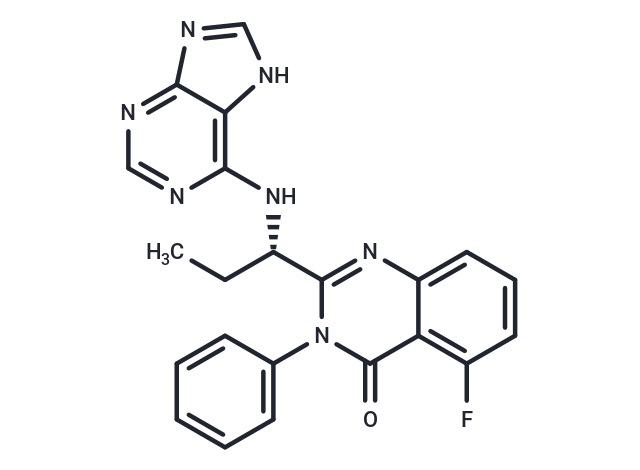Shopping Cart
- Remove All
 Your shopping cart is currently empty
Your shopping cart is currently empty

Idelalisib (GS-1101) is a small molecule inhibitor of the PI3K catalytic subunit p110δ (IC50: 2.5 nM). The selectivity for p110δ is 40- to 300-fold than p110α/β/γ.

| Pack Size | Price | Availability | Quantity |
|---|---|---|---|
| 5 mg | $30 | In Stock | |
| 10 mg | $43 | In Stock | |
| 25 mg | $68 | In Stock | |
| 50 mg | $85 | In Stock | |
| 100 mg | $110 | In Stock | |
| 200 mg | $143 | In Stock | |
| 500 mg | $237 | In Stock | |
| 1 mL x 10 mM (in DMSO) | $48 | In Stock |
| Description | Idelalisib (GS-1101) is a small molecule inhibitor of the PI3K catalytic subunit p110δ (IC50: 2.5 nM). The selectivity for p110δ is 40- to 300-fold than p110α/β/γ. |
| Targets&IC50 | p110β:565 nM (cell free), p110δ:2.5 nM (cell free), p110γ:89 nM (cell free) |
| In vitro | Idelalisib is an oral p110δ inhibitor currently under clinical evaluation in patients with B-cell malignancies. Idelalisib was 40- to 300-fold more selective for p110δ relative to other PI3K class I enzymes (IC50 p110δ = 2.5nM; p110α, p110β, and p110γ IC50 were 820, 565, and 89nM, respectively). Greater selectivity (400- to 4000-fold) was seen against related kinases C2β, hVPS34, DNA-PK, and mTOR, whereas no activity was observed against a panel of 402 diverse kinases at 10μM [1]. Idelalisib promoted apoptosis in primary CLL cells ex vivo in a dose- and time-dependent fashion that was independent of common prognostic markers. Idelalisib-mediated cytotoxicity was caspase-dependent and was not diminished by coculture on stromal cells [2]. CAL-101 inhibits CLL cell chemotaxis toward CXCL12 and CXCL13 and migration beneath stromal cells (pseudoemperipolesis). Idelalisib also down-regulates secretion of chemokines in stromal cocultures and after BCR triggering. Idelalisib reduces survival signals derived from the BCR or from nurse-like cells, and inhibits BCR- and chemokine-receptor-induced AKT and MAP kinase (ERK) activation [3]. |
| In vivo | A single intravenous dose of 40 mg/kg of Idelalisib, given 15 min before ischemia in wild-type mice (pre-treatment), significantly reduced infarction after 72 h. However, lower doses (20, 10 and 1 mg/kg) did not achieve significant protection. Importantly, even when given 3 h after the onset of reperfusion (post-treatment), a dose of 40 mg Idelalisib per kg body weight was still effective in reducing the infarct volume by an average of 44% compared with the vehicle-treated control group [4]. |
| Kinase Assay | PI3K assay was performed on whole-cell lysates from CLL or normal B cells. A PI3K ELISA assay was performed according to the manufacturer's instructions. Briefly, whole-cell extracts were added to a mixture of PI(4,5)P2 substrate and reaction buffer containing adenosine triphosphate (ATP) and allowed to incubate at room temperature. The reaction was stopped by adding PI(3,4,5)P3 detector mixed with EDTA (ethylenediaminetetraacetic acid) and allowed to incubate at room temperature for 1 hour. After this time, the mixture was transferred from each well to a PI3K ELISA plate and allowed to incubate 1 hour. Plates were washed and then incubated with a secondary detector for 30 minutes. Plates were washed again, and 3,3′,5,5′-tetramethylbenzidine solution was added for 5 minutes at which time H2SO4 was added to stop all reactions. Plates were read at 450 nm on a Labsystems 96-well plate reader [2]. |
| Cell Research | MTT assays were performed to determine cytotoxicity. Briefly, 1 × 10^5 cells (CLL B cells or healthy volunteer T cells or NK cells) were incubated for 48 hours with different concentrations of CAL-101, 25μM LY294002, or vehicle control. MTT reagent was then added, and plates were incubated for an additional 20 hours before washing with protamine sulfate in phosphate-buffered saline. Dimethyl sulfoxide was added, and absorbance was measured by spectrophotometry at 540 nm in a Labsystems plate reader. Cell viability was also measured at various time points with the use of annexin/PI flow cytometry. Data were analyzed with Expo-ADC32 software package. At least 10 000 cells were counted for each sample. Results were expressed as the percentage of total positive cells over untreated control. Experiments examining caspase-dependent apoptosis included the addition of 100μM Z-VAD. Experiments examining survival signals included the addition of 1 μg/mL CD40L, 800 U/mL IL-4, 50 ng/mL BAFF, 20 ng/mL TNF-α, or coculturing on fibronectin or stromal (HS-5 cell line) coated plates. Stromal coculture was done by plating a 75-cm2 flask (80%-100% confluent) per 6-well plate 24 hours before the addition of CLL cells [2]. |
| Animal Research | For Idelalisib (CAL-101) treatment, wild-type C57BL/6 mice were administered either 40 mg kg 1 CAL-101 or vehicle DMSO, by 25 ml infusion into the femoral vein, 15 min before I/R (pre-treatment), or 3 and 6 h after initiation of reperfusion (post-treatment). Controls and animals treated with CAL-101 underwent cerebral blood flow (CBF) measurements using a laser Doppler perfusion monitor. The CBF measurements obtained immediately before and after MCAO and again at 3 h after reperfusion showed a B90–95% reduction in the blood flow to the MCAO infarct region, which did not differ between groups [4]. |
| Alias | GS-1101, CAL-101 |
| Molecular Weight | 415.42 |
| Formula | C22H18FN7O |
| Cas No. | 870281-82-6 |
| Smiles | [C@H](NC1=C2C(N=CN2)=NC=N1)(CC)C=3N(C(=O)C=4C(N3)=CC=CC4F)C5=CC=CC=C5 |
| Relative Density. | 1.47 g/cm3 |
| Storage | Powder: -20°C for 3 years | In solvent: -80°C for 1 year | Shipping with blue ice. | ||||||||||||||||||||||||||||||||||||||||
| Solubility Information | H2O: Insoluble Ethanol: 22 mg/mL (52.96 mM), Sonication is recommended. DMSO: 50 mg/mL (120.36 mM), Sonication is recommended. | ||||||||||||||||||||||||||||||||||||||||
Solution Preparation Table | |||||||||||||||||||||||||||||||||||||||||
Ethanol/DMSO
DMSO
| |||||||||||||||||||||||||||||||||||||||||

Copyright © 2015-2025 TargetMol Chemicals Inc. All Rights Reserved.